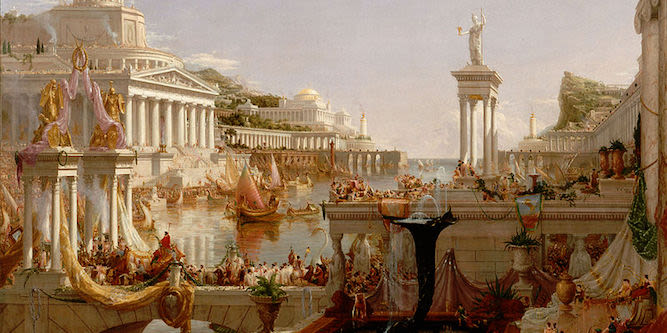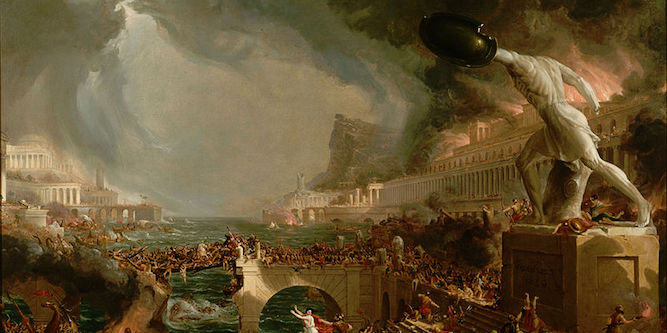
January 29, 2016
How Maritime Insurance Helped Build Ancient Rome
Tags:
How Maritime Insurance Helped Build Ancient Rome
January 29, 2016
(Thomas Cole, The Consummation of Empire, 1836, via Wikimedia)
He also used to lend money in what is surely the most disreputable form of speculation, that is the underwriting of ships.
– Plutarch on Cato the Elder
Insuring and financing voyages were high finance in the time of Ancient Rome. Each voyage was a risky, multi-million dollar venture, supported by a sophisticated financial apparatus. Before there were private equity and hedge funds, there was maritime insurance.
2,000 years ago, maritime insurance was essential to the survival of Rome, which had a population was the largest in the Western world until 18th century London. That’s because ancient sea transport is much more efficient than its alternative, the ox-drawn cart. (Past a certain distance, roughly 25 miles, oxen and horses eat more grain than they can carry.) It was much cheaper for Rome to import grain from Egypt than to haul it for 100 miles across the Italian peninsula.
But traveling to Rome by galley was risky: Storms, pirates, mutinies, and other perils threatened every voyage. Without the development of maritime insurance, and in particular a special type of loan, the city of Rome would never have received enough food to have become the major urban center that we still study today.
This piece introduces the unique financial loan Romans invented to insure maritime voyages and how maritime insurance helped guarantee the growth of the city.
A financial instrument as replacement to the Oracle
Maritime insurance is older than any other form of insurance by many centuries. It used to be much more speculative. In fact, a peculiar financial product emerged as a way to insure voyages.
Instead of paying a fee to insure cargo, merchants took out loans. These loans had very high interest rates and carried special terms: If the borrower couldn’t pay back the loan, then the creditor was able to seize the ship; in addition, if the ship sank, then the borrower didn’t have to pay back the creditor. The practice dates back to the Ancient Babylon of 1800 BCE. It’s known as “bottomry”: The owner of a ship borrows money on the “bottom” of the ship, so that if the borrower doesn’t pay back interest given a safe voyage, then he’d forfeit the ship.
To better illustrate how this policy worked, I put together a table on the three outcomes of a voyage:
| Voyage is successful | Voyage is safe, but the borrower can’t pay back the loan with interest | Voyage is not safe |
|---|---|---|
| The borrower repays the loan with interest, and everyone’s happy. | The creditor repossesses the ship. | The loan is void. Everyone loses, except maybe the pirates. |
In the book Chances Are…, Ellen and Michael Kaplan discusses just how innovative bottomry was:
It is an arrangement that is easy to describe but difficult to characterize: not a pure loan, because the lender accepts part of the risk; not a partnership, because the money to be repaid is specified; not pure insurance, because it does not specifically secure the risk to the merchant’s goods. It is perhaps best considered as a futures contract: the insurer has bought an option on the venture’s final value.
The attitudes towards the loans were almost as interesting as the loans themselves. Historians record that merchants and creditors thought of high interest rates explicitly as compensation for taking risk. Romans copied the practice of bottomry from the Greeks, and they also equated high interest rates with paying for risk. While Roman law capped interest rates at 12%, it sanctioned higher interest rates explicitly for maritime voyages because “the price is for the peril.”
Ancient finance was more sophisticated than you might think.
How maritime insurance fed Rome
Moses Finley, an influential historian has argued that wealthy Romans rarely engaged in financial innovations. He portrayed wealthy Romans as complacent landowners who mostly bought land, made interest-free loans, and spent their money on luxuries.
As it turns out, ancient Greeks and Romans were excellent capitalists. They set up banks that invested in real estate, with branches spanning the known world. They developed the first health insurance programs. They had proto-corporations known as societas, for which Romans pooled money to provide government services or collect taxes. (In the case of shipping, these transient organizations usually dissolved by the end of the voyage, when all parties received payment.) They developed some forms of life insurance. They even established a single grain market that extended across the Mediterranean. And Romans were of course also innovators in maritime insurance.
Historians estimate that the population of Ancient Rome (the city) peaked at between 500,000 to 1 million people.At that size, the city couldn’t survive without regular shipments of grain by sea. Peter Temin, an economic historian, has estimated that it would have taken 2,000 to 4,000 ship voyages each year to feed Rome at its peak. It was a sophisticated process. Roman agricultural products would be processed by machines, packed in amphorae, shipped in freighters, and distributed by inland waterways or roads.
Such a large trading system required a financial ecosystem to fund and insure each voyage. Every voyage was a feat of financial engineering, with multiple financial interests at play.
Creditors emerged as a class of financial intermediaries to provide bottomry loans. Not every lender operated on a large scale. Surviving records of maritime loans indicate that a ship was typically insured by more than one lender. Modern scholarship broadly agrees that the shipping industry—and by extension, ancient cities—depended on these bottomry loans. These loans were so common that Romans developed a standard boilerplate that parties could copy for each voyage.
The heroes in myths consulted the Oracle at Delphi before embarking on hazardous journeys. In reality, the Greeks invented insurance so that Poseidon (Neptune) could never completely bankrupt them.

(Thomas Cole, The Destruction of Empire, 1836, via Wikimedia)
How dangerous were sea voyages?
Today, maritime insurance is a $30 billion industry. That belies the fact that insuring cargo is incredibly cheap. It costs a few cents on the dollar to protect against the possibility of a container falling overboard in choppy seas. An estimated 2,000 to 10,000 containers fall into the sea every year, which is much less than 1% of all cargo shipped.
Shipwrecks aside, merchants and their financial backers were concerned as much if not more about everyday concerns. They worried about being paid in counterfeit currency; about captains pretending that their ship sank to avoid repaying bottomry loans; and about shippers stealing cargo or lying about prices. To manage this, lenders relied on a system of inspections, information sharing, and receipts designed to allow the insurers and financiers to detect and avoid fraud.
It’s tempting to view early traders as bold men who crossed treacherous seas to fill their holds in faraway lands. But captains rarely owned their own ships, and even merchants and captains who had the money preferred to finance their vessel, the voyage, and the insurance on each from maritime lenders who spread the risk. Indeed, the picture historians have sketched out is less Han Solo and more middle management.
Surgeons cut into patients thanks to hospitals’ liability insurance. Tom Cruise may brag about performing his own stunts, but the studio’s insurance agent must approve every one. Even the U.S. military purchases private insurance if its bases are attacked during peacetime.
Historians haven’t singled out bottomry loans and maritime insurance as the key to the success of Ancient Rome. Maritime finance is only one factor among many that allowed it to thrive.
Yet it’s clear that Ancient Rome—a city and empire that we associate with gladiators and civil wars, whose founding myth involves twin princes raised by a she-wolf—would not have become a wonder of the ancient world if it weren’t for the existence of an insurance industry that made trade boring, profitable, and dependable.
Read this next >> When America Dreamed of Nuclear-Powered Cargo Ships
About the Author
January 29, 2016




